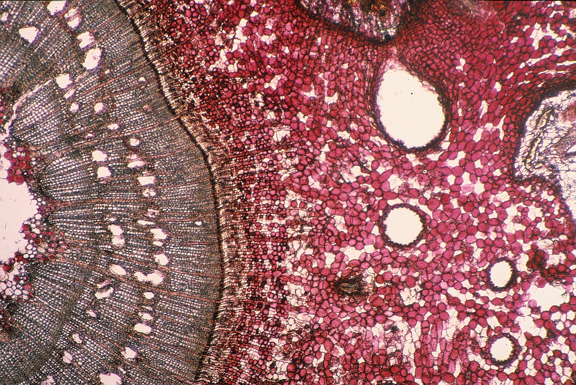Information Forestry, April 2008 — In order to measure a disease’s impact on a tree, you need to know when it became infected. This is difficult to do with root diseases: infection and disease progression occur underground, and above-ground symptoms may not show until years later, if ever. As well, root diseases progress through a stand with time of infections varying between trees.
Natural Resources Canada Root Diseases Research Scientist Mike Cruickshank recently determined how to date infections by root-rot fungus Armillaria ostoyae years after they occur.
His method traces a defense mechanism that occurs in most trees. When a tree is wounded or stressed, ducts called traumatic resin canals form under the tree’s cambium and around the affected tissue. If enough develop, the canals create a physical barrier between affected and healthy tissues. The barrier helps contain the infection.

Traumatic resin canal barriers form beneath a tree’s cambium layer in response to fungus infection. By tracing the canal positions preserved within tree rings to nearby lesions, researchers can determine when past infection events occurred.
The canals are preserved within the annual rings of root wood, which is how Cruickshank is able to trace them across the rings to specific fungus-caused lesions.
“Traumatic resin canals allow us to create a profile of infection events over time,” he says. If attacked once, a tree may contain an infection with canals, but the fungus may grow around the edges of the resin barrier and attack the roots elsewhere. “Being able to date infection events by year means we can go back and determine impacts of that particular infection—on growth and production in the tree, as well as subsequent effects in the stand.”
Knowing root disease impact would enable forest managers to more accurately predict future timber supply from high-risk stands, as well as to assess broader economic, silviculture, and climate change impacts.
Root diseases exist in most forests, but are especially common in tree plantations, particularly those where stumps of previously harvested trees are left in place before replanting.
Armillaria attacks the roots of all trees and many shrub and herb species native to British Columbia, but causes greatest mortality among Douglas-fir trees planted in the province’s interior. The fungus is prevalent across Canada and the northern hemisphere.
© Natural Resources Canada 2008
